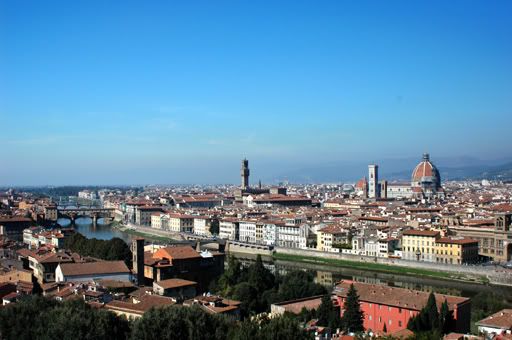
Florence or Firenze as it is known in Italy is a monument to the Renaissance; the artistic and cultural reawakening of the 15th century that brought Europe and consequently the rest of the Western World out of the devastation of the black plague that reduced the population of Europe by more than half. Appropriately enough, the period of enlightenment originated here in Florintia (Latin for flowering) as it was the cultural and intellectual heart of Europe, challenging the powerful church and state. Encapsulating new ideas such as the harmonious proportions of man, mathematical theories, and the scientific discoveries was the artistry known the world over as the age of humanism and that of the Renaissance.
Backed by wealthy patrons, such as the Alberti, the Albizi and the Medici families in the 14th and 15th centuries, artists such as Alberti, Brunelleschi, and Botticelli laid the seeds for giants like Leonardo di Vinci, Michelangelo, Titan, Giotto, Donattelo and Raphael to name but a few whom have created a period of unparalleled artistic growth.
The origin of Florence can be traced back to the middle of the 1st century B.C. as a Roman town possessing temples, baths, and amphitheatres. The advent of Christianity brought many new buildings such as the Santa Felicita, Santa Reparata and Santa Lorenzo. The decline of the church gave way to numerous succession of counts, barons, and feudal lords and subsequent merchants of the wool and silk industry altering the political, social and physical cityscape as buildings such as Palazzo Vecchio, the Loggia della Signora, Santa Croce, Santa Maria Novella, the Giotto’s Bell tower, the Cathedral and Brunelleschi’s Duomo and Pazzi chapel were added to the richness of a new era.
Arriving into Florence was like walking through the doors of one of my art history lectures that I took while attending architecture school a decade ago. The faint images of these masterpieces projected on the classroom wall are now transposed into the vibrant hues of marble, brick and terra cotta gleaming in the Tuscany sun. The monotone of the class room instructor is replaced with the noise of shuffling pedestrian feet, honking and peeping vehicular horns, the squeaking sounds of buses breaking, the relentless jack hammering, the revving sounds of scooters dodging in and out of traffic, the sounds of copious languages simultaneously describing the same thing as hordes of tour groups come and go, and of course the sounds of cameras clicking as we entered into the Piazza del Duomo the site of the Cathedral of Santa Maria del Foire.
 In true Renaissance fashion, the dominance of the Duomo stopped me dead in my tracks as I was frantically dodging from piazza to piazza searching throughout the city for affordable accommodation
In true Renaissance fashion, the dominance of the Duomo stopped me dead in my tracks as I was frantically dodging from piazza to piazza searching throughout the city for affordable accommodationMy tutor (a.k.a. Rav) along with her latest acquisition (Florence the complete guide to the city – which incidentally became the textbook for the next 4 days) and I were overwhelmed by the splendid nature of this entire city and we had only been there for a couple of hours.
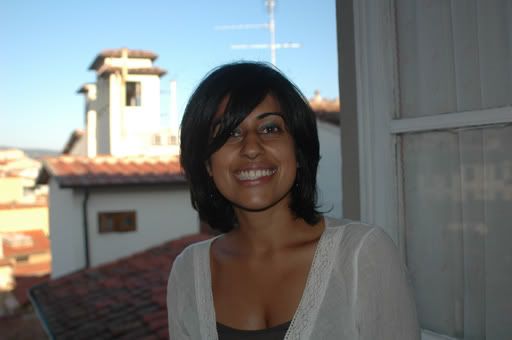 My eager tutor ready to hit the streets of Florence
My eager tutor ready to hit the streets of Florence  The presence of the magnificent dome by Brunelleschi and Giotto’s belltower dominate the Florence cityscape like sun in the sky. This jewel is located at the center of Florence and is considered to be the heart of the city
The presence of the magnificent dome by Brunelleschi and Giotto’s belltower dominate the Florence cityscape like sun in the sky. This jewel is located at the center of Florence and is considered to be the heart of the city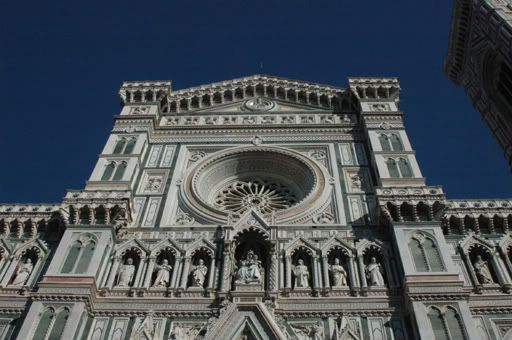 Originally designed in 1296 by Arnolfo di Cambio – regarded as the most magnificent expression of Medieval faith in the 13th century
Originally designed in 1296 by Arnolfo di Cambio – regarded as the most magnificent expression of Medieval faith in the 13th century The dome by Brunelleschi took over 14 years to build and it is regarded by most to be one of the fairest dome of all
The dome by Brunelleschi took over 14 years to build and it is regarded by most to be one of the fairest dome of all View of the dome and apse of the Cathedral
View of the dome and apse of the Cathedral Baptistry – dating back to the 5th century with traditional Romanesque green and white inlaid marble. Dedicated to St. John the Baptist, the Baptistry has three renowned doors that depict the stories of the bible
Baptistry – dating back to the 5th century with traditional Romanesque green and white inlaid marble. Dedicated to St. John the Baptist, the Baptistry has three renowned doors that depict the stories of the bible  David vs. Goliath – one of the 10 well decorated panels depicting biblical scenes adoring the East door (known as the bronze gilded Gate of Paradise)
David vs. Goliath – one of the 10 well decorated panels depicting biblical scenes adoring the East door (known as the bronze gilded Gate of Paradise)We could not give up an opportunity to walk through the dome to the top. For 6 Euros, we got to ascend more than 463 steps, some steep, some narrow and some just insanely hazardous due to the traffic coming the opposite way. The dome is actually comprised of two separate walls – an exterior and interior massive mason walls with a void in the middle broken by occasional struts and staircases that connect the two walls. At the top of the dome was a great view of the city, but it was also an opportunity to view the frescos on the ceiling of the dome that made the journey up the Duomo a treat.
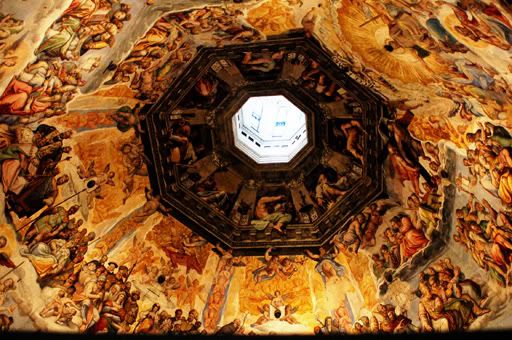 The painted ceiling of the dome of Santa Maria del Foire – full depiction of heaven and hell
The painted ceiling of the dome of Santa Maria del Foire – full depiction of heaven and hell A closer look at the difference between the two diverging worlds of heaven and hell
A closer look at the difference between the two diverging worlds of heaven and hell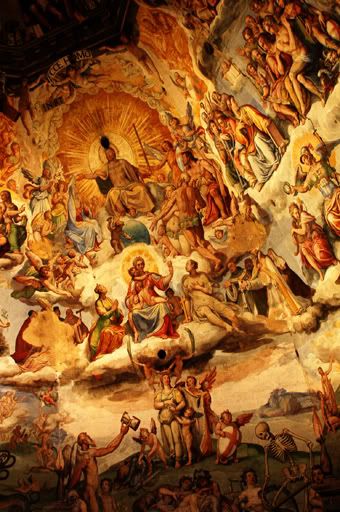 A peaceful depiction of the kingdom of heaven
A peaceful depiction of the kingdom of heaven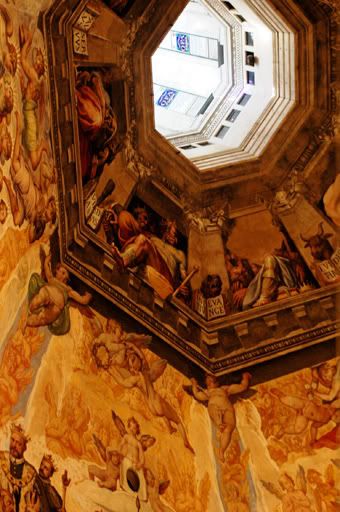 Angels can be seen holding up the columns that support heaven
Angels can be seen holding up the columns that support heaven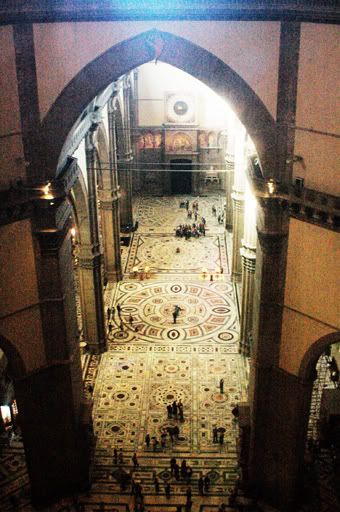 Looking back at the nave of the Cathedral – it was the first time we had a chance to see what god sees everyday. Santa Maria Del Foire is the third longest in the world at 148 m, after only St. Peter’s in Rome and St. Paul’s in London
Looking back at the nave of the Cathedral – it was the first time we had a chance to see what god sees everyday. Santa Maria Del Foire is the third longest in the world at 148 m, after only St. Peter’s in Rome and St. Paul’s in London 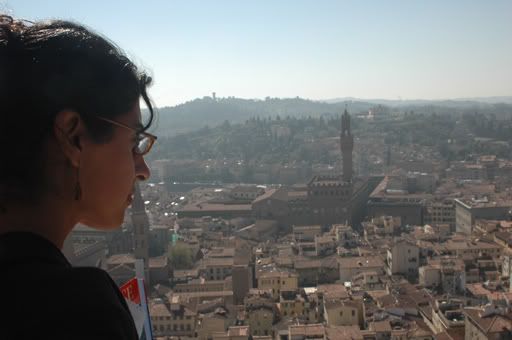 Rav enjoying the view from the top of the dome
Rav enjoying the view from the top of the dome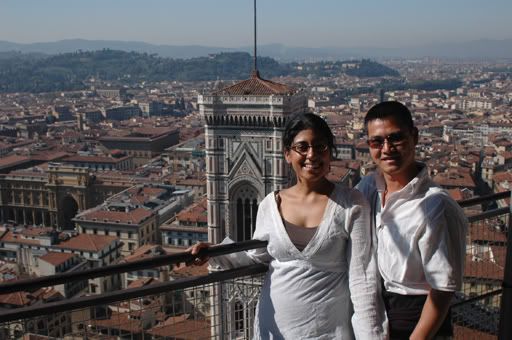 Chris and Rav with Giotto’s bell tower behind which incidentally has only 414 steps to the top. Construction of the tower began in 1334 and with Giotto’s passing in 1337 two of his pupils, Pisano and Talenti took over to complete the project. However, the spire in Giotto’s original plan was never built. The building is of remarkable grace and elegance; the structure lightens and lengthens as it rises, becoming complex with marble insets and fine perforation
Chris and Rav with Giotto’s bell tower behind which incidentally has only 414 steps to the top. Construction of the tower began in 1334 and with Giotto’s passing in 1337 two of his pupils, Pisano and Talenti took over to complete the project. However, the spire in Giotto’s original plan was never built. The building is of remarkable grace and elegance; the structure lightens and lengthens as it rises, becoming complex with marble insets and fine perforation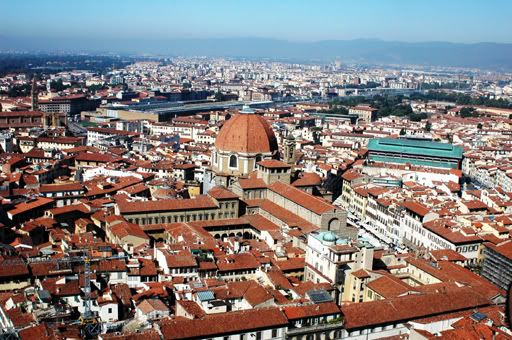 From the top of the dome we got a great view of San Lorenzo – one of the more impressive churches for its interior design and decor
From the top of the dome we got a great view of San Lorenzo – one of the more impressive churches for its interior design and decor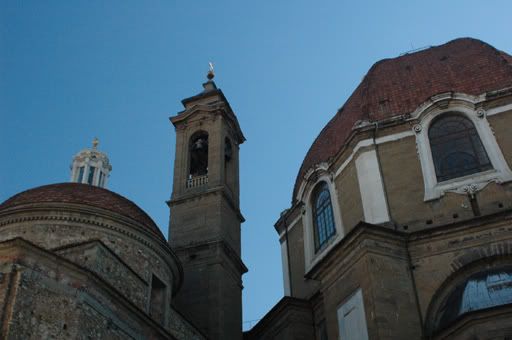 The serene domes and bell tower of the San Lorenzo. The harmonious proportions of the Renaissance were truly impressive and the light that filtered into the altar and nave were quite impressive and the frescos on the ceiling were even more impressive than that of the Duomo. I sat there staring at the dome forever, thinking about the space and the proportions. It was the first time that I realized the true meaning behind proportion and harmony and just how that can be a source of divine inspiration. It was my favorite church in Florence
The serene domes and bell tower of the San Lorenzo. The harmonious proportions of the Renaissance were truly impressive and the light that filtered into the altar and nave were quite impressive and the frescos on the ceiling were even more impressive than that of the Duomo. I sat there staring at the dome forever, thinking about the space and the proportions. It was the first time that I realized the true meaning behind proportion and harmony and just how that can be a source of divine inspiration. It was my favorite church in FlorenceSan Lorenzo was first built in the 11th century and was redesigned and added to in the 15th century by masters such as Brunelleschi, Manetti, and even Michelangelo designed the elevation of it although it was never built. However, he did design and build the balcony high up on the inner façade. The rugged yet plain exterior of San Lorenzo was in complete contrast to the interior where double rows of slender Corinthian columns surmounted by rounded arches rhythmically spaced along the nave and the typical grey and white plaster colour scheme combine to create an effect of incomparable harmony and elegance.
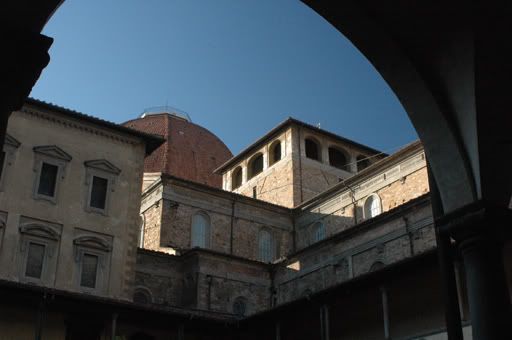 The dome of the San Lorenzo from the cloister. Photos were not allowed to be taken inside this church which was a real shame as I thought that the interior of this church was more superior to that of the Cathedral of Santa Maria del Foire. I cried like a baby when I heard that the famous Laurentian library and Michelangelo’s staircase was closed off to the general public for what else, but renovations
The dome of the San Lorenzo from the cloister. Photos were not allowed to be taken inside this church which was a real shame as I thought that the interior of this church was more superior to that of the Cathedral of Santa Maria del Foire. I cried like a baby when I heard that the famous Laurentian library and Michelangelo’s staircase was closed off to the general public for what else, but renovations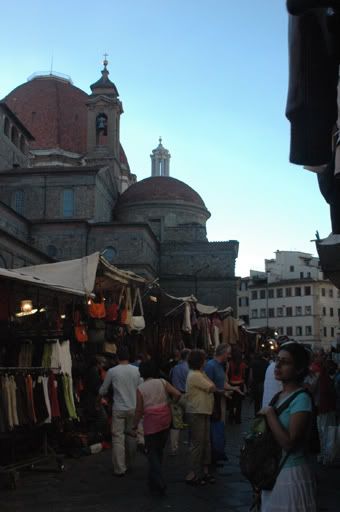 View of San Lorenzo from the outside along the many stalls selling everything under the sun. This must be the new church. Speaking of which there are way too many churches in Florence to see, luckily for us, some were closed due to renovations like the Santa Maria Novella, but the Santa Croce was open, so let’s go
View of San Lorenzo from the outside along the many stalls selling everything under the sun. This must be the new church. Speaking of which there are way too many churches in Florence to see, luckily for us, some were closed due to renovations like the Santa Maria Novella, but the Santa Croce was open, so let’s go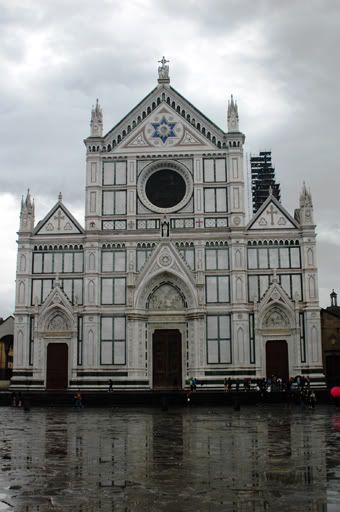 Front elevation of the Santa Croce - considered by many as one of the best Tuscan Gothic Churches. Construction began in the 2nd half of the 13th century and was completed in the 14th century
Front elevation of the Santa Croce - considered by many as one of the best Tuscan Gothic Churches. Construction began in the 2nd half of the 13th century and was completed in the 14th century 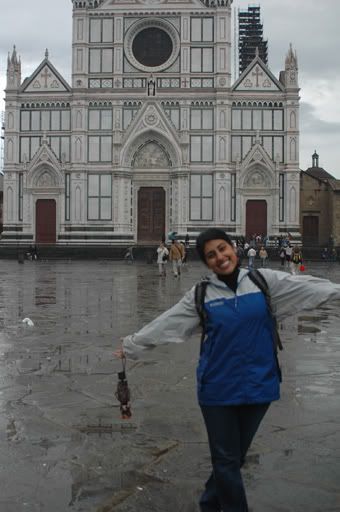 Rav dancing in the rain in front of Santa Croce where the addition of marble facade by Niccolo Matas was made in the 19th century
Rav dancing in the rain in front of Santa Croce where the addition of marble facade by Niccolo Matas was made in the 19th century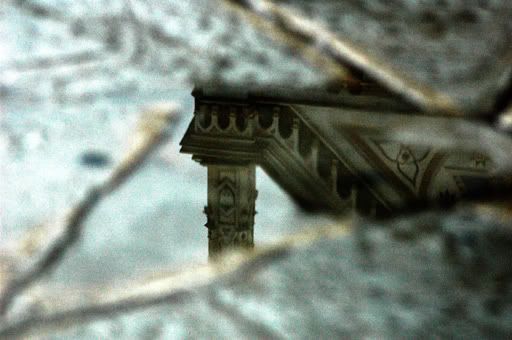 Reflection from a puddle in the gigantic square in front of the Santa Croce
Reflection from a puddle in the gigantic square in front of the Santa Croce The tomb of Michelangelo is located here along with that of Dante the philosopher. The interior of the church was mostly under scaffolding as the building was under renovation. The decorative frescoes adoring the main and side altars were hardly visible
The tomb of Michelangelo is located here along with that of Dante the philosopher. The interior of the church was mostly under scaffolding as the building was under renovation. The decorative frescoes adoring the main and side altars were hardly visible 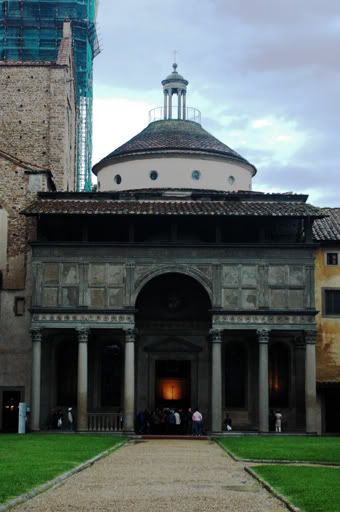 The Pazzi Chapel designed by Brunelleschi for the Pazzi family is considered to be the best of Brunelleschi’s creations. Not too bad, if you recall that he also designed the magnificent Duomo
The Pazzi Chapel designed by Brunelleschi for the Pazzi family is considered to be the best of Brunelleschi’s creations. Not too bad, if you recall that he also designed the magnificent DuomoWith so much great architecture in Florence, I could have spent my entire 4 days here just looking and trying to understand the spatial relationships and qualities, but there are also the famous art work that came out of the Renaissance era that could not be missed. Let’s start with the Uffizi Gallery and some of its treasures. Now the Uffizi Gallery is perhaps the most famous gallery in all of Florence, which is pretty impressive when you consider it does not even house any of Michelangelo’s sculptures. As recommended in the Lonely Planet, the queuing can be as long as 4 hours, so you best prepare. My tutor and I decided to hit the sack before midnight in order to be fresh and ready early for the next day’s lecture.
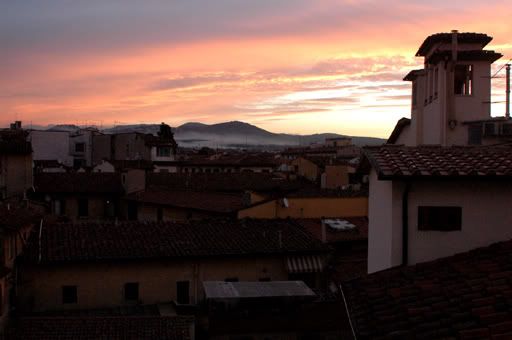 We got up with the sun to beat the line up at the Uffizi Gallery – this was the view from our pensione, not too bad for 45 Euros a night. I finally found this one after a two hour search.
We got up with the sun to beat the line up at the Uffizi Gallery – this was the view from our pensione, not too bad for 45 Euros a night. I finally found this one after a two hour search.The Uffizi Gallery is not only the oldest art gallery in the world, but also the most important in all of Italy, and one of the greatest in Europe. With such acclamation it is not surprising that more than 1.5 million people visit it annually. The gallery owns about 4,800 works, only half are on view (1000 paintings, 300 sculptures, 46 tapestries, and 700 paintings kept in the Vasari corridor). It is now under constant renovation and expansion to house all of its collections. Some of the most famous of these include: Giotto’s Enthroned Madonna and Child with Angles, Annunciation by Simone Martine and Lippo Memmi, Botticelli’s Allegory of Spring and the Birth of Venus, the Tribuna room, Cupid playing a lute by Fiorentino (Rav’s favorite), The Doni Tondo (Holy Family) by Michelangelo, (does this guy ever sleep?), and The Venus of Urbino by Titian (said to be the most seductive nude of all time). Now multiply that by about 4000 times and you get the point. NO pictures were allowed so we apologize for the lack of images of these beautiful pieces of art. The 9.5 Euro entry fee also included sketches and sculptures and innovative theory and designs by Leonardo di Vinci. It was 9.5 Euros well spent.
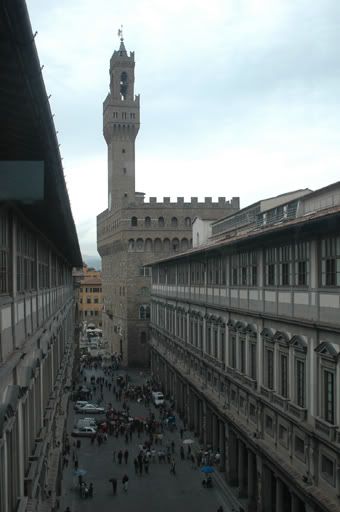 The Uffizi Gallery houses many of the finest art pieces that Italy has to offer. Unfortunately photos were not allowed
The Uffizi Gallery houses many of the finest art pieces that Italy has to offer. Unfortunately photos were not allowed Clock tower of the Palazzo Vecchio which houses over 500 paintings on the ceilings and walls. It was formerly used as the head quarters of the main communal authorities throughout the 14th century and the headquarters of the Medici clan up until the 16th century
Clock tower of the Palazzo Vecchio which houses over 500 paintings on the ceilings and walls. It was formerly used as the head quarters of the main communal authorities throughout the 14th century and the headquarters of the Medici clan up until the 16th century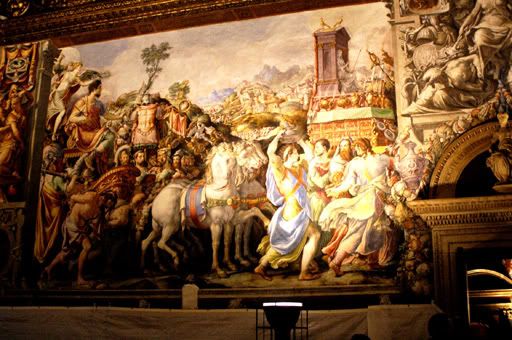 One of the 500 large paintings on the walls and ceilings of the Palazzo Vecchio – this one must have been over 50 feet long and 30 feet high.
One of the 500 large paintings on the walls and ceilings of the Palazzo Vecchio – this one must have been over 50 feet long and 30 feet high. 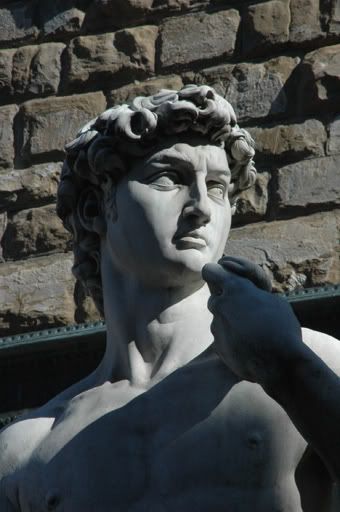 Replica of Michelangelo’s David at the Piazza Signoria, the original once stood here, but due to graffiti and weathering it has been moved to Galleria dell’Accademia. It is a magnificent sculpture. Unfortunately no photos were allowed at Galleria dell’Accademia either so none of the really impressive sculptures and paintings can be shown here
Replica of Michelangelo’s David at the Piazza Signoria, the original once stood here, but due to graffiti and weathering it has been moved to Galleria dell’Accademia. It is a magnificent sculpture. Unfortunately no photos were allowed at Galleria dell’Accademia either so none of the really impressive sculptures and paintings can be shown here 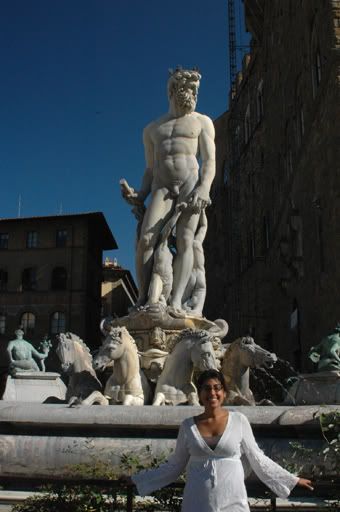 Rav with a statue of Neptune by Bartolomeo Ammannati at the Piazza Signoria
Rav with a statue of Neptune by Bartolomeo Ammannati at the Piazza Signoria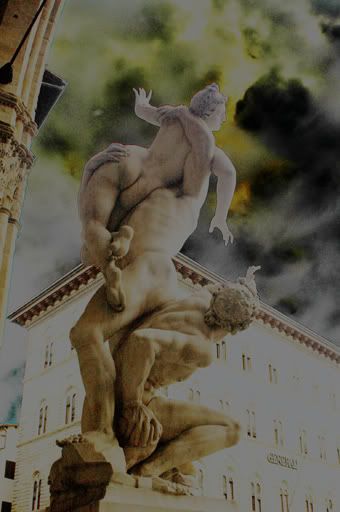 Rape of a Sabine Woman by Giambologna, a superb piece that commanded my attention despite all of the other great pieces close by
Rape of a Sabine Woman by Giambologna, a superb piece that commanded my attention despite all of the other great pieces close by 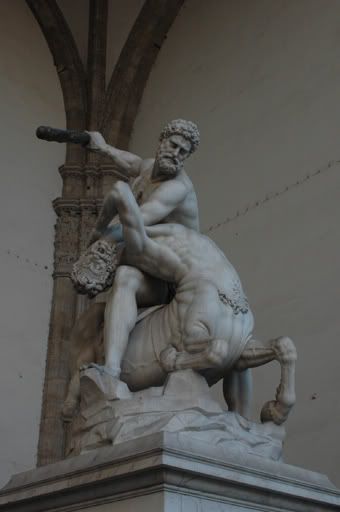 Not sure of the title of this one, but it is pretty good
Not sure of the title of this one, but it is pretty goodThere was more to Florence than just churches and galleries mind you. We had a good couple of days just wandering through the streets to discover some of the other things that Florence had to offer. These include:
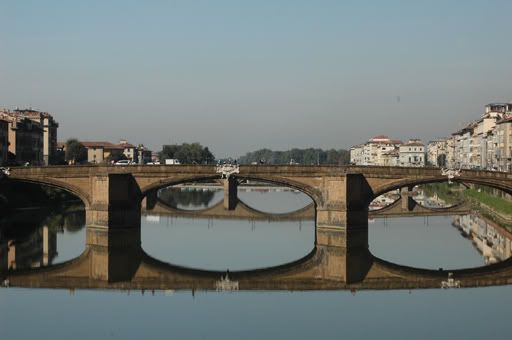 Ponte Vecchio – this is the oldest bridge in all of Florence and flanking along its sides are small shops on stilts
Ponte Vecchio – this is the oldest bridge in all of Florence and flanking along its sides are small shops on stilts  Originally these shops included butchers, shoemakers, grocers, and gold and black smiths. In the 16th century Ferdinando I evicted all except the goldsmiths. To this day the bridge has been home to only jewelry shops
Originally these shops included butchers, shoemakers, grocers, and gold and black smiths. In the 16th century Ferdinando I evicted all except the goldsmiths. To this day the bridge has been home to only jewelry shops 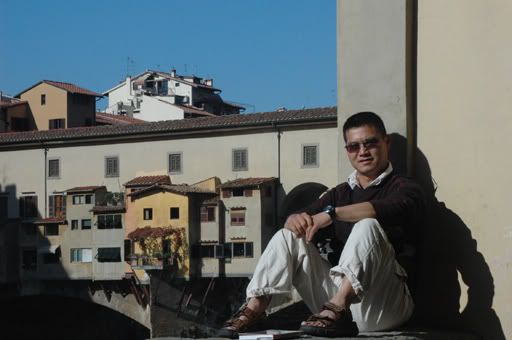 Here I am pondering on how to steal all of that gold so we can keep on traveling
Here I am pondering on how to steal all of that gold so we can keep on traveling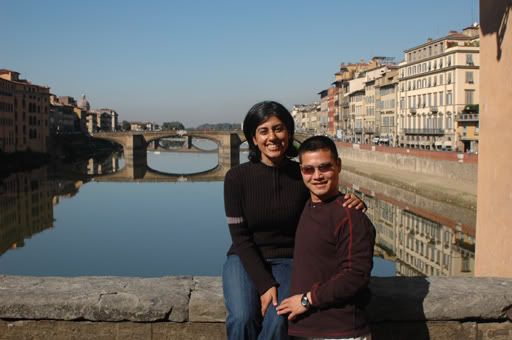 Me with my new girlfriend Neevar at the Ponte Vecchio
Me with my new girlfriend Neevar at the Ponte Vecchio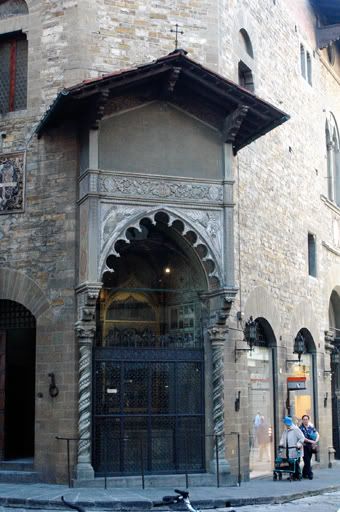 The guildhall of the wool merchants. It was a very nice entry I thought. It reminded me of the Alhambra in Granada, Spain
The guildhall of the wool merchants. It was a very nice entry I thought. It reminded me of the Alhambra in Granada, Spain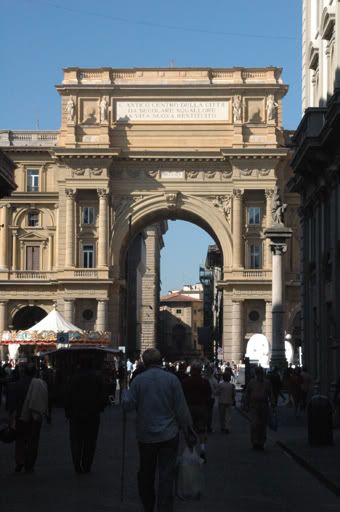 Piazza Repubblica -formerly the site of a Roman Forum today it is lined with pricey cafes, poshy restaurants and cheap knock off leather purse, belt, and jacket stalls
Piazza Repubblica -formerly the site of a Roman Forum today it is lined with pricey cafes, poshy restaurants and cheap knock off leather purse, belt, and jacket stalls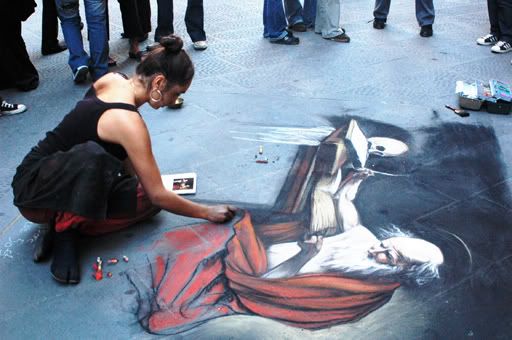 The next generation of Michelangelo or Di Vinci perhaps
The next generation of Michelangelo or Di Vinci perhaps Neevar enjoying a cold one at the Pizza de Michelangelo overlooking the city of Florence
Neevar enjoying a cold one at the Pizza de Michelangelo overlooking the city of Florence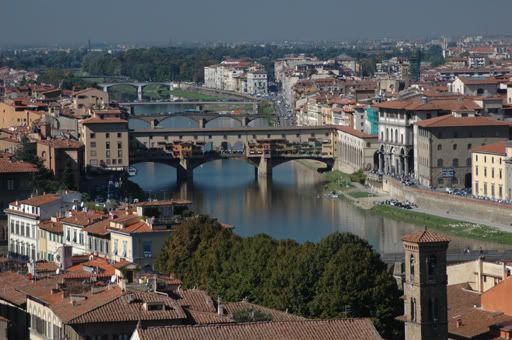 Not a bad way to spend the last afternoon we had in Florence
Not a bad way to spend the last afternoon we had in Florence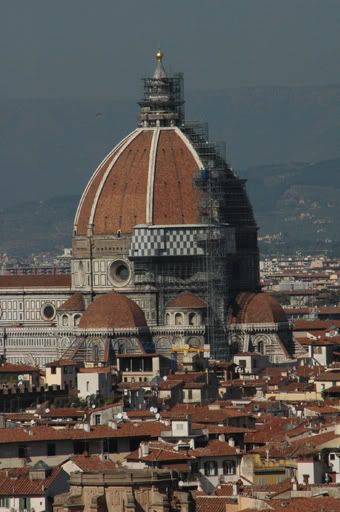 One last look at the great Duomo
One last look at the great Duomo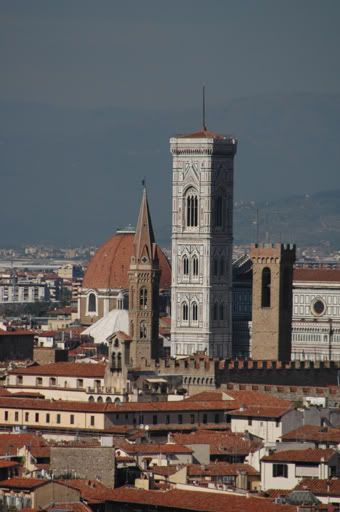 Giotto’s bell tower and San Lorenzo behind – another magical image of the city of Florence
Giotto’s bell tower and San Lorenzo behind – another magical image of the city of Florence Neevar and I at Piazza Michelangelo
Neevar and I at Piazza MichelangeloWe had decided to make Florence our home for 6 nights, as we were tired of moving every two to three days. And as much as we love the cobble stones, the wheels on our duffel bags are starting to really show signs of wear and tear. After a two hour search within the city, where everything was booked solid, and what was not booked was only available for one or two nights at a cost of 85-110 Euros a night for a double with a private bathroom, I found the Albergo Marcella. This was a family run pensione for 45 Euros a night, close to the train station and only minutes away from all that Florence is famous for. Our room at the top of the building was spacious, bright and very clean. The view was to die for. Even though the bathroom was just down the hall, it was not too much of an inconvenience, although the noisy youngsters in the hostel next door were a bit of a nuisance. Florence is a great city, but we also had read about Pisa and Siena, two cities close enough that we could get to from Florence in an hour or so. We took advantage of that fact and planned two field trips to each of the cities.
Despite its rich history as one of Rome’s premiere naval base in the 9th century, and later in the 12th and 13th century as a maritime power rivaling Genoa and Venice, Pisa is most famous today for its Leaning Tower. This architectural hiccup has put Pisa back on the international map.
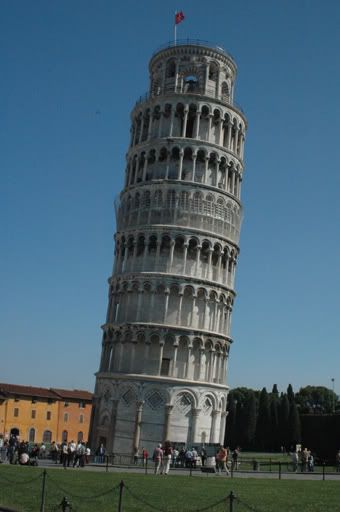 The Leaning Tower of Pisa – it is quite amazing that it is still standing. Leaning more than 5m from the central axis
The Leaning Tower of Pisa – it is quite amazing that it is still standing. Leaning more than 5m from the central axis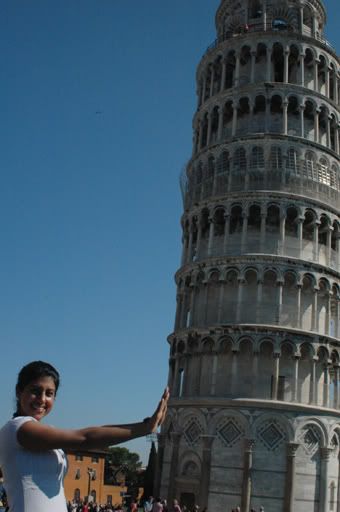 Rav trying to push the leaning tower over… not too successful because the foundation has been rectified in 1998. Therefore the leaning tower will lean no further
Rav trying to push the leaning tower over… not too successful because the foundation has been rectified in 1998. Therefore the leaning tower will lean no further 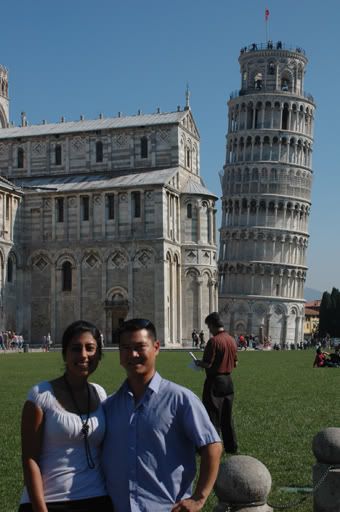 Rav and I at the Cathedral and the Leaning Tower of Pisa – shifting soil is the most favoured explanation for why it leans
Rav and I at the Cathedral and the Leaning Tower of Pisa – shifting soil is the most favoured explanation for why it leans View of the back of the Cathedral’s main altar from the top of the tower of Pisa. The construction of the Cathedral began in 1064 and was not completed until the end of the 16th century. This Cathedral’s elegant design made it a model for Romanesque churches throughout the Tuscany region
View of the back of the Cathedral’s main altar from the top of the tower of Pisa. The construction of the Cathedral began in 1064 and was not completed until the end of the 16th century. This Cathedral’s elegant design made it a model for Romanesque churches throughout the Tuscany region  Shadow of the leaning tower. From here you can not tell that the tower actually started leaning before the construction was completed, and continued to tilt 1mm every year
Shadow of the leaning tower. From here you can not tell that the tower actually started leaning before the construction was completed, and continued to tilt 1mm every year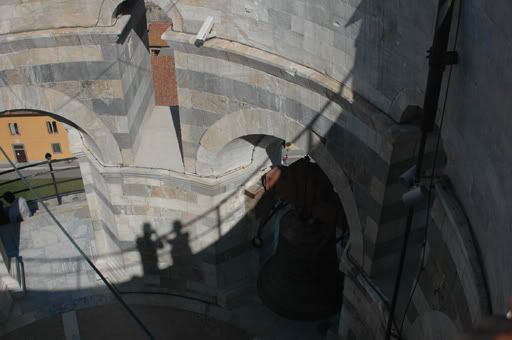 Our shadow from the top of the tower, we were not the only two people up there that day. The line up was long, and only a certain number of people were allowed to be on top of the tower at a time. The circular staircase had 300 steps to the top and the lean of the tower made it very difficult at times to walk upright. The marble steps are also quite worn out at certain locations making the climb even more treacherous. Coming down was even more difficult, the uneven steps and the lack of a grip along with the gravitational pull made it feel like you had a couple of bottles of vino. Which we did not have, we swear. No drinking during class
Our shadow from the top of the tower, we were not the only two people up there that day. The line up was long, and only a certain number of people were allowed to be on top of the tower at a time. The circular staircase had 300 steps to the top and the lean of the tower made it very difficult at times to walk upright. The marble steps are also quite worn out at certain locations making the climb even more treacherous. Coming down was even more difficult, the uneven steps and the lack of a grip along with the gravitational pull made it feel like you had a couple of bottles of vino. Which we did not have, we swear. No drinking during class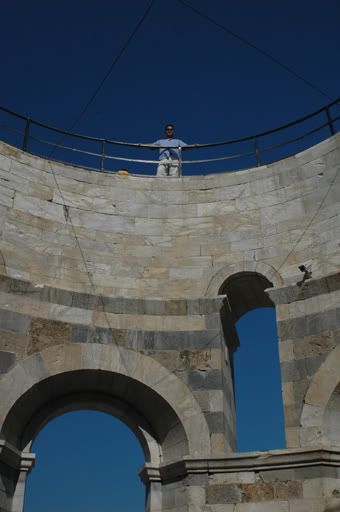 I’m somewhere up there…when everyone else has already gone down, I stayed up here for as long as I could to get my 15 Euros worth. I figured it to be about 0.2733 of my Euros for every mm that it is leaning over. That is a pretty steep price to pay
I’m somewhere up there…when everyone else has already gone down, I stayed up here for as long as I could to get my 15 Euros worth. I figured it to be about 0.2733 of my Euros for every mm that it is leaning over. That is a pretty steep price to pay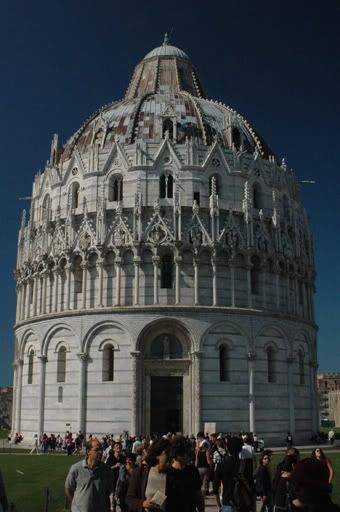 Baptistry – 4 centuries of construction meant that the final design was a fusion of Romanesque and Gothic. It is circular in shape and is capped off with a dome
Baptistry – 4 centuries of construction meant that the final design was a fusion of Romanesque and Gothic. It is circular in shape and is capped off with a dome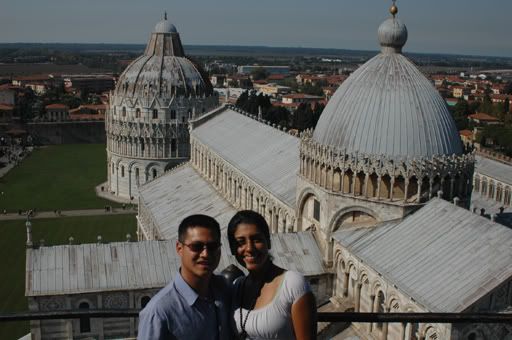 Here we are at the top of the tower with the Cathedral in the back ground. It was a picturesque day in the city of Pisa. Okay lets get the heck off this thing before it decides to continue to lean a little more
Here we are at the top of the tower with the Cathedral in the back ground. It was a picturesque day in the city of Pisa. Okay lets get the heck off this thing before it decides to continue to lean a little more Rav on the Ponte Soflerino in front of the Chiesa di Santa Maria della Spina over looking the Arno river. This is the same river that runs through Florence
Rav on the Ponte Soflerino in front of the Chiesa di Santa Maria della Spina over looking the Arno river. This is the same river that runs through FlorenceSiena was another city close to Florence that we wanted to visit. Unlike Pisa, which is situated on the west coast of Italy, Siena is landlocked, located in the southeast corner of the Tuscany region. While Florence flourished in the Renaissance period, Siena’s artistic glories are a couple of centuries early in the form of Gothic. The most famous of all is the medieval center, the Piazza del Campo which is a world renowned public square.
 The scallop shaped slanting Piazza del Campo has been the town’s civic center ever since the Council of Nine staked it out in the 14th century. The square is divided into 9 sectors representing the Council of Nine. When we arrived at the square there were loads of people just sitting on the ground, some having lunch, others sun bathing, still others moving in herds from one spot to the next. We just stood there for a while and people watched
The scallop shaped slanting Piazza del Campo has been the town’s civic center ever since the Council of Nine staked it out in the 14th century. The square is divided into 9 sectors representing the Council of Nine. When we arrived at the square there were loads of people just sitting on the ground, some having lunch, others sun bathing, still others moving in herds from one spot to the next. We just stood there for a while and people watched Palazzo Comunale – town hall at the bottom of the slanted square. The lower level of the palazzo façade features a characteristic Sienese-Gothic arcade
Palazzo Comunale – town hall at the bottom of the slanted square. The lower level of the palazzo façade features a characteristic Sienese-Gothic arcade 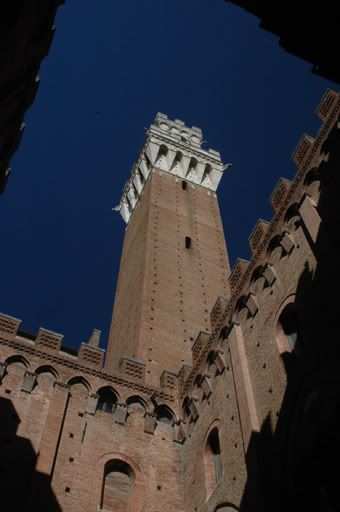 Torre del Mangia - the city Icon, its graceful bell tower completed in 1297
Torre del Mangia - the city Icon, its graceful bell tower completed in 1297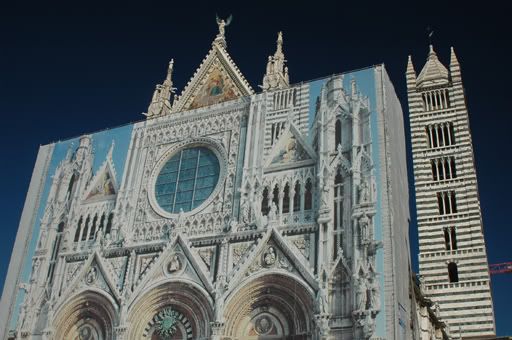 The Cathedral, one of Italy’s greatest Gothic Churches started construction in 1196 and was completed in 1215. Today it is under a veil of scaffolding and plastic tarps. The motionless steeples are replaced by moving cranes. Much to our dismay, the church is under renovation to restore it to its former glory days. We decided to skip the line up and were just as happy to meander through the crooked streets that seem to go in circles for the duration of the day
The Cathedral, one of Italy’s greatest Gothic Churches started construction in 1196 and was completed in 1215. Today it is under a veil of scaffolding and plastic tarps. The motionless steeples are replaced by moving cranes. Much to our dismay, the church is under renovation to restore it to its former glory days. We decided to skip the line up and were just as happy to meander through the crooked streets that seem to go in circles for the duration of the day We came across some more churches and of course piazzas galore. Some more magnificent than others, like this one, the Chiesa di San Francesco on a hill top
We came across some more churches and of course piazzas galore. Some more magnificent than others, like this one, the Chiesa di San Francesco on a hill top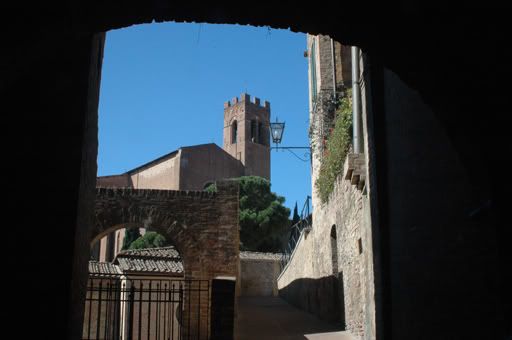 And the Oratorio di San Bernardino
And the Oratorio di San BernardinoIt was a nice pace to the rest of the afternoon as we were not too concerned about getting lost. Lunch was great at a local family run restaurant (Trattoria La Torre). When we asked the waitress for the menu, she called her father over, and he spewed out a long list of items in Italian. We simply smiled and looked at each other. We ended up filling our tummies with some delicious home made pasta even though the portions did not look that big when it first arrived.
Siena was a pleasant town that took you back in time, all the way to the middle ages it would seem. There is really not much to do there, other than visit the Piazza del Campo and the Cathedral. The ringing of the church bells reminded me of the bell to end the day’s lecture so we hiked back to the train station, leaving the old city quarter in the middle of the afternoon to board a train back to Florence along with the rest of the local school kids.
Well what can you say about Florence, a city that was mentioned to overwhelm you, add to that two amazing cities in their own right – “information overload” comes to mind. Looking back now it was the best art history class I had attended and the tutor’s kinda cute, but Neevar oh Neevar, she’s a whole different story! Wink, wink, nudge nudge….If Florence is the Athens of Italy, I wonder what Rome is going to be like? Stay tuned…
Chunger the perpetual student
 Florence or Firenze as it is known in Italy is a monument to the Renaissance; the artistic and cultural reawakening of the 15th century that brought Europe and consequently the rest of the Western World out of the devastation of the black plague that reduced the population of Europe by more than half. Appropriately enough, the period of enlightenment originated here in Florintia (Latin for flowering) as it was the cultural and intellectual heart of Europe, challenging the powerful church and state. Encapsulating new ideas such as the harmonious proportions of man, mathematical theories, and the scientific discoveries was the artistry known the world over as the age of humanism and that of the Renaissance.
Florence or Firenze as it is known in Italy is a monument to the Renaissance; the artistic and cultural reawakening of the 15th century that brought Europe and consequently the rest of the Western World out of the devastation of the black plague that reduced the population of Europe by more than half. Appropriately enough, the period of enlightenment originated here in Florintia (Latin for flowering) as it was the cultural and intellectual heart of Europe, challenging the powerful church and state. Encapsulating new ideas such as the harmonious proportions of man, mathematical theories, and the scientific discoveries was the artistry known the world over as the age of humanism and that of the Renaissance. 



























































3 comments:
i didn't know that Florence was the home of Leonardo, Michelangelo, Donattelo and Raphael! So how come i didn't see any sculptures of turtles? I mean mutant turtles skilled in the art of kickin' ass like ninjas, HOW COOL IS THAT! no wonder they liked eating pizzas, living in Italy and all. it must have been disappointing not to have been able to see them or that rat dude master of theirs'.
But looks like you guys had a good time anyhow.
one other thing, are you guys involved in a hair transplanting experiment in exchange for cheap room and board? it would appear that Chris periodically looses all of his hair and Rav just keeps getting more and more hair. just a thought...
Hello,
Just killing a couple of minutes from work here. Not sure if your still in florence, but if you are there a great camp ground overlooking the river and to downtown florence and at night time you get a great show of all the stars. I don't know the name of the campground, its been awhile since I've been to florence.
Come on Rav, near death experinces. I bet the drop was no more then 1';-). Where the picture showing you hanging over the cliff?
Both of you are looking great, but have to say Chris is getting a little chubby. I guess I know who carrying all the bags. Anyway have fun. Can't wait to see you both in the New Year.
Later
Loc
Hey you two!
Thanks for another art history lesson that I took in while having lunch. You had your very own 'Room with a View' - what a find. I now realize I missed a lot when in Florence, ah well the next best thing is reading about it in this blog.
As for Rav's hair. To me it looks like you got a stylish new haircut (as opposed to it getting longer). Who is right?
- Tara
Post a Comment